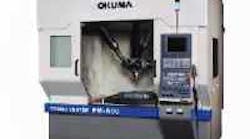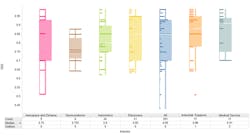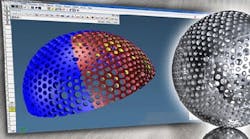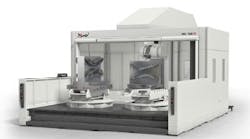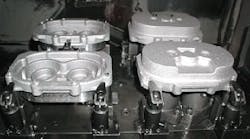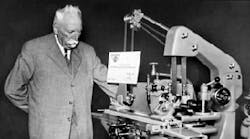Didn't make it to the show? Here's a rundown of some of the highlights.
Okuma Cosmo PM-600 parallel- mechanism machine
Olympic Seiki’s relative-movement technology
Flow's 87,000-psi HyperJet waterjet cutting system
Jung's J 630 high-precision surface and profile grinding machine from United Grinding Technologies
Hardinge's hydrostatic linear guideways for lathes
The Cooled Nut from Steinmeyer Inc.
Makino’s 1-Series of horizontal machining centers
A turning center and vertical machining center from Mazak’s Nexus Series
Fadal’s EMC entry-level mill
Liberty Precision's Quad Spindle configuration
Reconfigurable machine tool (RMT)
The MultiTec machining system from Ingersoll
The Z4-500 laser cutting system from Haas Automation
While attendance might have been down a bit, the good news at IMTS was that there was no shortage of new equipment introductions, especially in the machine tool pavilions. Innovations were everywhere, but what drew most eyes were technologies focusing on speed, accuracy, affordability, and as always, increased production.
For instance, it was hard walk past the Okuma without taking a glance Cosmo PM-600 parallel-mechanism machine. This quick machine moves at 100 m/min and accelerates/decelerates at 1.5 G. According to the Char-lotte-based company, the Cosmo offers high-efficiency die/ mold machining with less polishing and integrates operations for cutting complicated shapes.
Add a 40-taper spindle turning up to 12,000 min -1 , and the result is a fast and productive machine. The spindle slants within a range of ±25°, and a 20-station toolchanger keeps it supplied for continuous operation. Cosmo axis travels measure 23.26 in. for X and Y, while the Z is 15.75 in. Ballscrews instead of linear motors give speed to three new Olympic Seiki machines, sold in the U.S. by Vigor Machinery in Rancho Cucamonga, Calif. The mill/tap center, S-650 machining center, and the inverted-spindle vertical lathe all incorporate the Taiwanese builder's relative-movement design, which produces 100 m/min and an acc/dec rate as fast as 2 G.
The simple concept uses a ballscrew with a right-hand thread at one end and a left-hand thread at the other. When activated, the ballscrew moves two opposite surfaces, such as table and spindle, toward or away from each other. Moving two surfaces simultaneously slashes the distance they have to travel in half and makes travels faster.
For 40% faster waterjet cutting, Flow International Corp. introduced its HyperJet system, with a Hyper Pressure waterjet pump producing 87,000 psi. The Kent, Wash., company expects the machine to revolutionize cutting for the sheetmetal industries.
To further optimize sheetmetal cutting, the HyperJet moves material from left to right under a cutting head, which moves from front to back. Splitting the cutting motion between the workpiece and cutting head improves the dynamics of motion for faster and more precise cutting. The machine also consumes 40% less abrasives.
ACCURACY
For ultrafine finishes on tough materials and micron-precise contours and profiles, United Grinding Technologies (UGT), Miamisburg, Ohio, offered the J 630 CNC high-precision surface and profile grinding machine from Jung. One of the grinder's attention-getting features — besides its submicron accuracy — was a PA 31 dressing system, which lets shops do continuous-profile wheel dressing simultaneously with the grinding process. According to UGT, this reduces grinding times as much as 50%, especially for difficult-to-cut materials.
The PA 31 system has direct measuring as well as axis drives along with high-resolution contour accuracy. Its spoked diamond head with four diamonds and quick-change clamping system tackles both roughing and finishing. With micron-precise positioning accuracy, the system's profile-width area is 50 mm and its profile depth is 15 mm inside/20 mm outside.
In the machine tool components arena, Hardinge Inc. and Steinmeyer Inc. debuted two technologies that make machine tools more accurate. Hardinge of Elmira, N.Y., exhibited its hydrostatic linear guideways for lathes, while Steinmeyer of Bedford, Mass., showcased water-cooled ballscrew nuts.
Hardinge conducted a comparative demonstration of the damping qualities between its hydrostatic linear guides and conventional linear ball guides. It displayed its hydrostatic guides on a Quest 8/51 lathe. The company showed that the new guides not only improved dynamic stiffness for heavy cutting and chatter resistance but also delivered 9 more damping as compared to conventional linear ball guides.
For machines using ballscrews, Steinmeyer's Cooled Nut incorporates coolant channels in the nut body without increasing its overall dimensions. Coolant ports are on the flange and connect water line. Water channels span the entire length of the nut, running through the flange as well, to form a thermal barrier that prevents from migrating into the slide. Typically, only ballscrews are cooled, but according to Steinmeyer, heat generated inside the nut passes to the ballscrew, and it must be dissipated. In addition, cooling just the nut is easier because it doesn't rotate.
AFFORDABILITY
At some booths, the overall theme was new machines for new markets. Builders such as Makino, Mazak, and Fadal all showcased equipment targeted outside their usual spectrums. Both Makino and Mazak, known for their high-end precision machines, launched more standard value-oriented machine lines, as did Fadal with its latest venture, the EMC vertical.
The Makino 1-Series of horizontal machining centers includes the a51, a71, and a81 models. With a 400-mm pallet, the a51 features a 12,000-spindle and ring-60-tool magazine. The a71 is a 500-mm-pallet machine with a 50-taper spindle, while the a81 sports a 630-mm pallet and 50-taper spindle. According to the Mason, Ohio, company, the 1-Series machines are well suited for applications requiring less precision but at the same productivity and reliability levels of Makino's high-end machines.
The Nexus line of machines, says Mazak, Florence, Ky., provides affordable advanced technology and productivity. Within the series are the Nexus 410A and 510C vertical machining centers — both with 25-hp, 12,000-rpm spindles (40-hp, 15,000 and 25,000-rpm optional). Both machines rapid at 1,417 ipm with a 2.9-sec chip-to-chip time. The 410A handles workpieces weighing up to 1,100 lb, while the 510C accommodates up to 2,640 lb.
Also in the series are the QT Nexus 100 and 200 turning centers, which sport a 6 and 8-in. chuck, respectively. Spindle speed for the 100 is 6,000 rpm with 15 hp, and its 12-tool drum turret indexes in 0.2 sec. The 200 incorporates a 5,000-rpm spindle with 35 hp. It has a 40.2-in. maximum machining length and also a 0.2-sec turret-indexing time.
For Fadal of Chatsworth, Calif., the market focus was on first-time users and dedicated applications when it introduced its EMC entry-level mill. The machine joins the company's Standard Series VMCs and features a 7,500-rpm spindle with 12 hp. Its X, Y, and Z travels measure 20 in., 16 in., and 14 in., and its 3-hp axis motors deliver 2,500 lb of thrust for cutting speeds up to 600 ipm and rapids up to 700 ipm.
The EMC weighs 4,800 lb and handles a maximum weight of 1,000 lb. With 16 pockets, the machine's ATC accommodates up to 4.6-in.-diameter tools weighing as much as 15 lb. An MP CNC delivers a processing speed of 3,000 block/sec.
INCREASED PRODUCTION
For increased high-volume manufacturing and flexibility, Liberty Precision Industries in Rochester introduced its BA series of horizontal machining centers featuring Twin and Quad Spindle technologies. The series consists of three models: the BA 400-2, BA 400-4, and the BA 600-2. Twin spindles are on the 400-2 and 600-2 models, while the 400-4 sports four high-speed spindles.
The idea behind the series is to simultaneously machine two or four parts to double or quadruple output as compared to a single-spindle machine. And despite their high output, says Liberty, the machines retain the flexibility of most CNC machining centers via part swappers, toolchangers, and four/five-axis machining.
All three models have an automatic work changer with two horizontal-fixture trunnions mounted to a main trunnion swapper. This setup lets users orient the trunnions to present parts in an inverted fashion for chip removal.
The trunnions swap in 6 sec and accommodate a rotary fifth axis for five-sided part processing in one setup. At the machine's outboard load/unload station, the horizontal trunnion positions workpieces for easy handling while the machine is running another part. In addition, it supports a fixture for a wash/blow-off cycle to remove chips.
Adding to the BA machines' productivity are high-speed spindles. The 400-4's four spindles are 17,500 rpm with 16 kW of power; the 400-2 sports two 12,500-rpm, 36-kW spindles; and the two spindles on the 600-2 are 10,000 rpm with 42 kW of power. The 600-2 includes two 40- pocket tool chains. The 400- 2 has two 30-pocket tool chains, and the 400-4 comes with four 30-pocket tool chains.
A new concept in productivity was found at the Masco booth. However, there wasn't the usual array of machines on display. Instead, the Cleveland machine tool company donated its booth space to the University of Michigan NSF Engineering Research Center for Reconfigurable Manufacturing Systems, which showcased its conceptual arch-type reconfigurable machine tool (RMT). RMTs are designed around the common characteristics of part families. They reconfigure not only to perform all necessary operations on part-family members but also to adapt to future part styles.
Lamb Technicon of Warren, Mich., provided engineering design and developmental assistance for the RMT, while Masco built the machine that features 3-axis kinematics with the functionality of a 4 or 5-axis machine. Rotational motion of the spindle around the workpiece and along the arch gives the machine its reconfigurability. The spindle positions at five different angles: 45°, 30°, 15°, 0°, and 15°.
For a typical aluminum workpiece, the RMT mills using a cutter diameter up to 3.2 in. at a 0.1-in. depth of cut with speeds between 2,000 and 4,000 sfm. It also drills cored holes up to 0.5 in. at feeds of 40 to 50 sfm and speeds to 0.009 ipr. Geared for doing more with less, Ingersoll's MultiTec machining system combines multiple technologies — milling, grinding, turning, turn-milling, and five-axis milling — in a single machine to increase production. The system replaces several conventional machines while also eliminating multiple setups and reducing non-cut times.
Five basic machine types are available in horizontal, vertical, and gantry-style configurations. For milling, the machines come with spindles for speeds from 3,000 to 40,000 rpm, which are partnered with 60,000-mm/min linear-axis feedrates. Grinding units provide surface finishes of 0.2-µ Ra.
For shops looking to increase production by expanding into laser cutting, Haas Automation of Oxnard, Calif., displayed its Z Series laser-cutting systems. They combine the rigidity and accuracy of the company's VMCs with the reliability and features of Coherent Diamond-Series lasers. The ZM-100 starts with the company's Mini Mill platform and adds a 100-W, sealed CO2 pulsed laser to 16 1210-in. X,Y, and Z travels. The Z3-500 and Z4-500 have travels measuring 40 2025 in. a n d 50 2025 in., respectively. A 500-W laser does the cutting for those models. Z Series laser systems also come with full fourth and fifth-axis capabilities for multisided parts and complex operations in a single setup.
